Paris Peace Conference (1919)
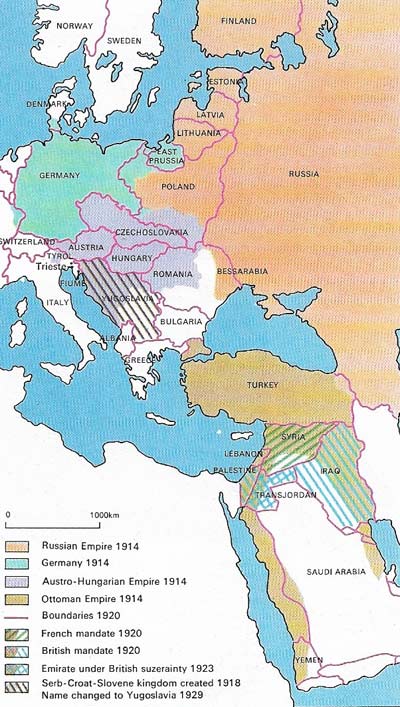
Figure 1. The new East European states emerged from the wreckage of the German, Austro-Hungarian, and Russian empires. Although founded on the basis of national self-determination, they also included alien minorities like the Germans in Czechoslovakia. They were a source of constant unrest after 1919. Britain and France divided the former Ottoman Middle East between them, but both faced rising Arab nationalism and, in Britain's case, increasing Arab-Zionist conflict in Palestine. In the Ottoman Empire nationalists formally established the Republic of Turkey in 1923.
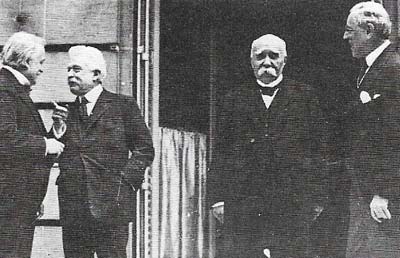
Figure 2. The Allied leaders (from left to right) Lloyd George, Orlando, Clemenceau, and Wilson, were bitterly divided by conflicting policies and temperamental differences. The peace settlement they eventually imposed on Germany was soon condemned by their countrymen and they did not remain in office for long after it. The treaty was signed in 1919 by all the great powers except the United States.
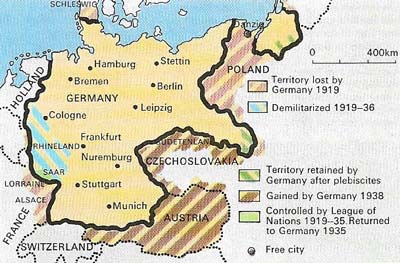
Figure 3. Germany's losses and gains from 1919 to 1938 as shown on this map. The Supreme Council had endeavored to settle Germany's frontiers on the basis of nationality. Its territorial losses, in the east particularly, were a cause of Germany's detestation of the treaty. Allied disunity and weakness in 1938 enabled Hitler to incorporate Austria into the Reich and to annex the German Sudetenland.
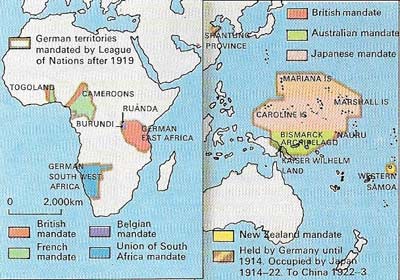
Figure 4. Germany lost all its colonies at the end of World War I. Woodrow Wilson hoped that the captured German colonies would be administered directly by the League of Nations. This idea was opposed by the British Dominions and Japan, which had conquered them. A compromise was reached by the system of "A", "B" and "C" was virtually indistinguishable from annexation. Thus Wilsonian idealism was again frustrated by the other powers.
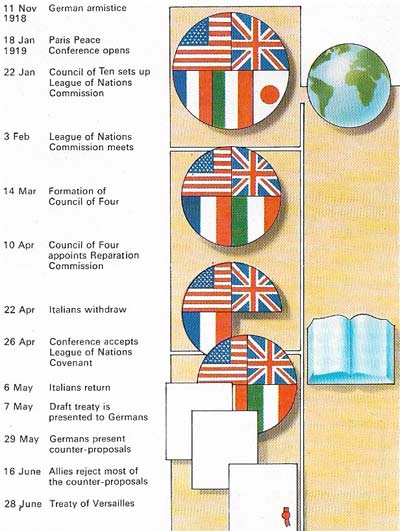
Figure 5. A quick conclusion to the peace conference was essential, to permit European reconstruction. Although attended by most nations and governments, it was soon dominated by Britain, France, and the USA.
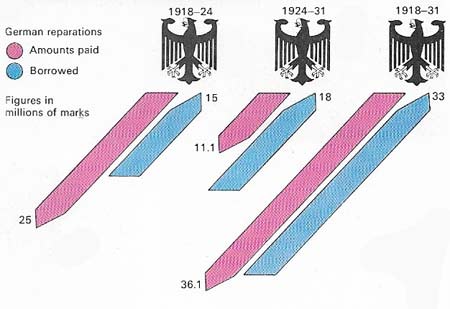
Figure 6. Germany's reparations payments were a major obstacle to her economic reconstruction and weakened the entire European economy in the 1920s. But after the French invasion of the Ruhr and the dramatic German inflation in 1923 the need for a strong German economy was recognized, leading to increased investment, especially from the USA. Much of this investment however, was spent on public buildings.
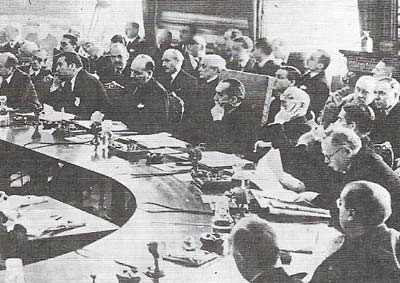
Figure 7. The League of Nations was intended by Woodrow Wilson to be the foundation of a new and peaceful world order. However, the USA's refusal to join in 1920 and the exclusion of both Germany and Soviet Russia (until 1934) reduced its prestige. After the admission of Germany in 1926 the League was fairly successful, until its failure to prevent the Japanese conquest of Manchuria in 1931–1932 and the Italian conquest of Ethiopia, 1935–1936.
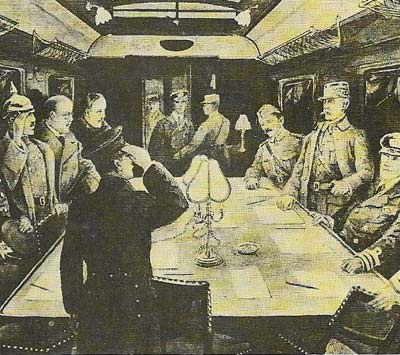
Figure 8. The armistice was signed on 11 November 1918 at the French headquarters in the Forest of Compiegne. Marshall Foch signed for the Allies. It secured Germany's evacuation of occupied territories and a complete cessation of all hostilities.
The Paris Peace Conference, formally opened on 18 January 1919, was dominated by the five leading victorious powers of World War I – the United States, France, the British Empire, Italy, and Japan. The defeated nations and Russia were excluded.
Conflicting demands
The French delegation, led by Prime Minister Georges Clemenceau (1841–1929), was obsessed with the long-term threat posed to France by Germany's larger population and superior industrial potential and demanded the imposition of a harsh treaty that would prevent any further German aggression against France. The French aims conflicted with those of the President of the United States, Woodrow Wilson (1856–1924) who, in his Fourteen Points (accepted with certain reservations by Britain and France on 4 November 1918), called for a peace settlement based on national self-determination and a League of Nations (Figure 2).
Britain's major demands had already been met with the surrender of the German fleet and the British occupation of most of Germany's colonies and the bulk of the Turkish Middle East. Despite pressure from Wilson that these areas should be administered directly by the League, they were retained by the British Empire under a complex League mandate system (Figure 4). Thus the British Prime Minister, David Lloyd George (1863–1945), was in a position to mediate between the French and the Americans.
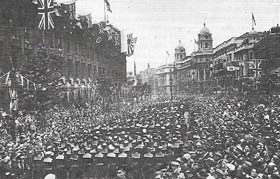 |
| British troops marched along Whitehall, London, in July 1919 in a "Peace Procession" that marked the signing of the treaty of Versailles. But disillusionment soon replaced enthusiasm. |
Italy demanded the satisfaction of its claims under the 1915 Treaty of London to the Tyrol, Trieste and a large part of the Slav-populated Dalmatian coast, including Fiume. The Italians were unable to persuade Wilson to agree to their claim to Fiume, which was assigned to Yugoslavia, leaving Italy with Trieste and the Tyrol (Figure 5).
Despite strong opposition from Wilson and the Chinese, Japan secured the former German concessions in Chinese Shantung promised to it by the entente in 1917.
Wilson's ideals compromised
The Republican victory in the November congressional elections in America undermined Wilson's prestige and he was forced to compromise on some of the Fourteen Points in order to secure the adherence of the other leaders to his League of Nations Covenant. However, neither he nor Lloyd George would accept France's demand for a Rhineland buffer state under French military control. This would have been a clear breach of the principle of national self-determination and, in Lloyd George's view, was likely to breed lasting German resentment. The French accepted a compromise on 14 April whereby the Allies were to occupy a demilitarized Rhineland, including the Rhine bridgeheads, for 15 years, with an Anglo-American guarantee to protect France against German aggression. The French were also given permission to exploit the valuable Saar coalfields.
Despite Wilson's strenuous opposition France also demanded massive reparations from Germany, not only to compensate for the immense destruction inflicted during the war but also as a means of weakening the German economy (Figure 6). Lloyd George was, by the end of March, becoming concerned at the increasing severity of the Allied demands on Germany which he feared would hinder Germany's economic recovery and lead to the creation of a Bolshevik Germany.
Eventually a compromise was reached that left the total sum owed by Germany to be determined by an inter-Allied reparation commission by 1921. Meanwhile Germany was forced to accept responsibility for causing the war. The Allies also imposed a substantial measure of disarmament on the German army, navy, and air force.
The eventual compromise
The three leaders could not agree about the settlement of Germany's eastern borders. France supported large territorial gains at Germany's expense by the newly established East European states, especially Poland. After a long struggle Lloyd George managed to reduce Poland's acquisitions by insisting on a League-controlled free port of Danzig, the reduction of the Polish corridor and a plebiscite in Upper Silesia. Czechoslovakia retained the German Sudetenland. Austria, stripped of its former empire, was forbidden to unite with Germany. In 1920 Hungary lost all its non-Magyar lands to its neighbors and a severe peace was imposed on Turkey (Figure 1).
The Allies finally presented the draft treaty to Germany on 7 May, giving her 15 days to draw up counter-proposals, the bulk of which were rejected. After further delays Germany signed the treaty at Versailles on 28 June 1919. It was widely regarded in Germany as a dictated peace and a betrayal of Wilsonian principles. Failure to apply the principle of self-determination to the distribution of the German countries of the former Austrian Empire, in particular, was a major German grievance and one that gave the German nationalists and Hitler's Nazi Party valuable propaganda against the Weimar Republic in the 1920s (Figure 3).
The United States Senate rejected the treaty and the League covenant, and the United States retreated into isolationism. France thus lost the Anglo-American guarantee and became even more determined to insist on German compliance with the treaty, especially the reparations clauses. This intransigent attitude led to considerable friction with Britain.
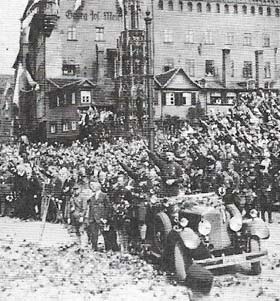 |
| Hitler's rise to power in 1933 and the Treaty of Versailles are not directly connected, but the treaty was used as an important element in Nazi propaganda against the Weimar Republic and the Social Democrats in the 1920s. Hitler's appointment as chancellor was the product both of luck and calculation. His opportunity was provided by general discontent in the economic depression, and the inability of Weimar politicians to cope with either. |
